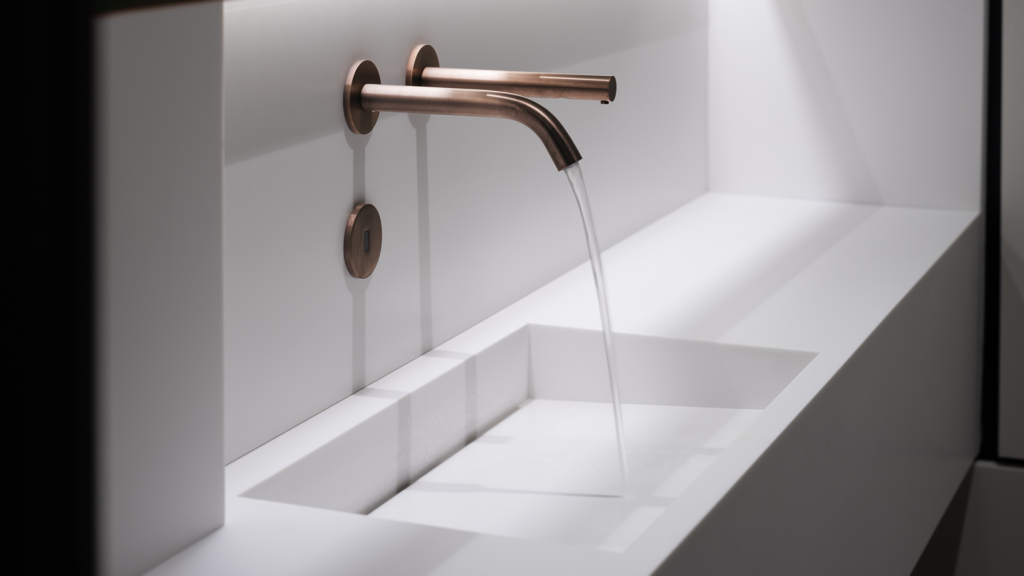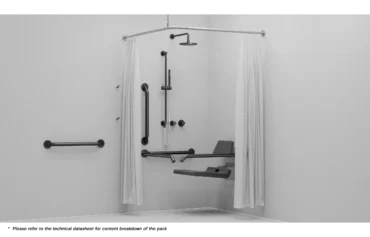How would it feel to use a space designed with someone else in mind? Perhaps it’s too fiddly, too difficult to see, or puts everything out of reach. At best, it might be frustrating, at worst it could be dangerous.
These are just a few of the barriers that some disabled people face when accessible bathroom design isn’t prioritised.
Understanding disability in the UK
Understanding disabled people’s experiences can help in designing more welcoming, inclusive spaces.

A recent report sheds light on how many of us may face daily struggles. In 2022, an estimated 16.1 million people in the UK were
living with a disability.
This includes both mental and physical health conditions that last at least 12 months and make it harder to do day-to-day activities. The most widely reported disability was mobility issues, followed by stamina/breathing/fatigue, mental health, and then dexterity.
The report also explored how disabilities are linked to well-being. While everyone’s experiences will be unique, disabled people generally reported higher levels of loneliness and anxiety and lower levels of happiness than non-disabled people.
In another survey, over a quarter of disabled respondents said they often had
difficulties accessing public buildings. Among the myriad of accessible design concerns, bathrooms come up time and again.
No matter the type of space, from public buildings to workplaces to leisure spaces, washroom design choices can have a profound impact on both safety and inclusion.
Accessible bathroom concerns
Washrooms are intimate, personal, and essential spaces. Without suitable access, people are placed in serious situations. Some even see toilets as a kind of material marker of disabled people’s exclusion from the community. After all, how can people participate in spaces that don’t include them by design?
With disabilities presenting in such diverse ways, barriers will look different for everyone. One person may find it difficult to see bathroom accessories without contrasting colours, for instance. Another person with limited dexterity may find operating a push-button flush impossible. Someone else’s independence may be subject to grab rails that help with balance.
So, what can architects and designers do to create safe and accessible bathrooms that alleviate exclusion?
Practical washroom accessibility
At a practical level, there are specific elements needed for compliant bathrooms. UK legislation details these requirements through regulations such as:
- Access to and use of buildings: Approved Document M (often called Doc M)
- BS 8300:2009+A1:2010 (BS8300)
- Disability Discrimination Act 2005 (DDA)
You can find out more in our recent
article on UK regulations.
Including the right accessories and fixtures, in the right way, can open up washrooms and convey dignity and independence on users. From appropriate grab rail positioning to contrasting finishes, these are not add-ons, they are the essentials.
But good bathroom design is about more than simply meeting requirements. Creating a harmonious experience means weaving this usability into the overall vision.
Aesthetic, inclusive design examples
Creating a consistent, coordinated look can be a challenge when working to tight specifications. But accessibility doesn’t mean compromising on aesthetics.
The Splash Lab has created beautifully elegant, modular and compliant bathroom products. Our packs come in a choice of contemporary PVD finishes for a seamless look across a range of areas, including end-of-journey facilities.
So, designers can craft well-considered accessible spaces that align with their vision, bringing comfort and dignity to users.

Doc M Packs
Each of our
Doc M Packs was designed as a whole, offering matching options while complying with Approved Document Part M of The Building Regulations.
These include:
- Ambulant Packs for those with limited mobility who do not require a wheelchair
- Accessible Packs to create barrier-free cubicles for those using wheelchairs
- Doc M Shower Packs featuring both exposed and concealed showers
- A well-designed space
Our team is happy to talk through your inclusive design options. For more information on creating an accessible washroom.
Reach out for a consultation





 A recent report sheds light on how many of us may face daily struggles. In 2022, an estimated 16.1 million people in the UK were living with a disability.
This includes both mental and physical health conditions that last at least 12 months and make it harder to do day-to-day activities. The most widely reported disability was mobility issues, followed by stamina/breathing/fatigue, mental health, and then dexterity.
The report also explored how disabilities are linked to well-being. While everyone’s experiences will be unique, disabled people generally reported higher levels of loneliness and anxiety and lower levels of happiness than non-disabled people.
In another survey, over a quarter of disabled respondents said they often had difficulties accessing public buildings. Among the myriad of accessible design concerns, bathrooms come up time and again.
No matter the type of space, from public buildings to workplaces to leisure spaces, washroom design choices can have a profound impact on both safety and inclusion.
A recent report sheds light on how many of us may face daily struggles. In 2022, an estimated 16.1 million people in the UK were living with a disability.
This includes both mental and physical health conditions that last at least 12 months and make it harder to do day-to-day activities. The most widely reported disability was mobility issues, followed by stamina/breathing/fatigue, mental health, and then dexterity.
The report also explored how disabilities are linked to well-being. While everyone’s experiences will be unique, disabled people generally reported higher levels of loneliness and anxiety and lower levels of happiness than non-disabled people.
In another survey, over a quarter of disabled respondents said they often had difficulties accessing public buildings. Among the myriad of accessible design concerns, bathrooms come up time and again.
No matter the type of space, from public buildings to workplaces to leisure spaces, washroom design choices can have a profound impact on both safety and inclusion.
